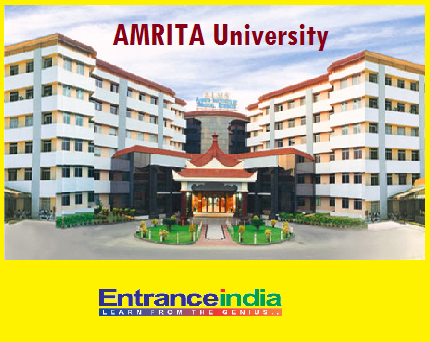AMRITA ENGINEERING ENTRANCE EXAMINATION
Amrita Engineering College is one of the best colleges in India. The campus of the institution is located at five places Amritapuri (kollam), Kochi, Bangalore, Coimbatore and Mysore. The institution contains programs and researches in various fields like Medical, Engineering, Management, Science and Education, Mass Communication and Social Work. About 15,000 students are been studying across all these campuses. It attained its University status in the year 1956 by UGC. The headquarters of the University is located at Coimbatore. The University has accredited with ‘A’ grade by the NAAC. The admission for the University is conducted by entrance test. The test is mainly conducted for engineering stream. The branches for which the entrance test is done are;
- Aerospace Engineering
- Electrical and Electronics Engineering
- Electronics and Communication Engineering
- Computer Science and Engineering
- Civil Engineering
- Chemical Engineering
- Electronics and Instrumentation Engineering
- Mechanical Engineering
Eligibility
Aspirants who have completed 10th and 12th with minimum aggregate of 60% in Physics, Chemistry and Mathematics in any of the following board of education State board, CBSE or any other education departments are eligible. Candidate who have completed three year diploma courses in their respective branches with minimum 60% aggregate are eligible to apply. Candidates who are waiting for their results are eligible. Candidates must have 17 years at the time of admission
Exam Pattern
The exam paper consists of 120 multiple choice questions. Each question carries three marks each. One mark will be reduced for each wrong answer. The questions allotted for the following subjects are;
- Physics: 30 questions
- Chemistry: 30 questions
- Mathematics: 40 questions
The Marks allotted are 120, 90 and 90 respectively. The candidates who have shortlisted from the entrance exam have to attend the counseling. The time duration for the exam is two and half hours. The examination is of two types;
- Computer based Exam
- Pen and Paper based Exam
For the exams, the candidate has to select two examination centres. The hall tickets can be downloaded by providing application number and Date of Birth. The candidates attending the counseling has to submit the following documents;
- Recent passport size photos
- 10th and 12th mark sheet
- Caste certificate if needed
- Hall tickets of 12th examination and Amrita entrance examination
- Proof of Date of Birth
- Original shall be submitted at the time of counseling else the candidate will not be able to attend the counseling
- Counseling charge is Rs 5000/- which is non refundable
Syllabus
The exam syllabus is to cover all the subjects as per Higher Secondary level.
How to Apply
- Log onto the official website
- Create a profile in Amrita Admission portal
- Fill all the mandatory details
- Select the mode of examination, test centre and test date
- Confirm all details
- Upload the candidate photograph and signature
- Elect the mode of payment for online pay Rs 1000/.using Net banking, credit/debit cards. In case of offline through Demand draft, in favour of Amrita School of Engineering payable at Coimbatore
- In case of online take the printout for future reference
- There is no option of changing the examination center or counseling process
In case of offline mode, print the application form and send it along with the demand draft to following address;
Admission Coordinator,
Amrita School of Engineering
Amrita Vishwa Vidyapeetham,
Amritanagar, Coimbatore – 641112
Tamil Nadu, India.